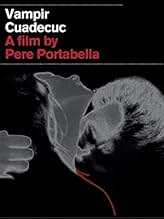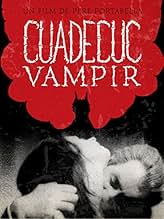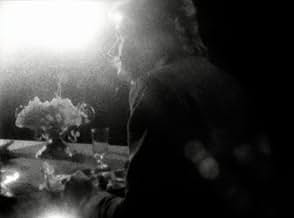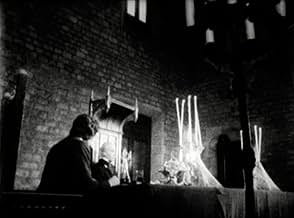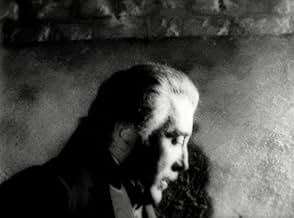An analysis of the construction mechanism for the magic in dominant narrative cinema though the filming of Count Dracula (1970), a commercial film by Jesús Franco.An analysis of the construction mechanism for the magic in dominant narrative cinema though the filming of Count Dracula (1970), a commercial film by Jesús Franco.An analysis of the construction mechanism for the magic in dominant narrative cinema though the filming of Count Dracula (1970), a commercial film by Jesús Franco.
- Director
- Writers
- Stars
Christopher Lee
- Self
- (as Cristopher Lee)
- …
Emma Cohen
- Self
- (uncredited)
- …
Jesús Franco
- Self
- (uncredited)
- …
Colette Jack
- Self
- (uncredited)
- …
Jeannine Mestre
- Self
- (uncredited)
- …
Paul Muller
- Self
- (uncredited)
- …
Maria Rohm
- Self
- (uncredited)
- …
Fred Williams
- Self
- (uncredited)
- …
- Director
- Writers
- All cast & crew
- Production, box office & more at IMDbPro
Featured reviews
In this curio, Pere Portabella filmed many silent scenes from Jess Franco's 1970 production, the oft-derided 'El Conde Dracula', and pieced them together. His images are deliberately very grainy and clumsy, as if his goal is to create a documentary-style product - Portabella was by this point known as a documentary director after all. Christopher Lee as the main man features here, alongside other stars Soledad Miranda, Herbert Lom and Franco himself.
Any time we are in danger of being treated to moments from the familiar story, there are inserts from behind the scenes featuring false cobwebs being sprayed over coffins, a poor old rubber bat being coerced into action, and general larks from the cast and crew. What results is a curious hybrid of genuinely unsettling scenes, often filmed without dialogue and saturated with unearthly moans and noises, in stark, heavily-grained black and white.
In fact, the only dialogue we're treated to is at the end of the film, with Christopher Lee's very grand reading of a scene from the novel.
The whole experience is an odd one, and certainly not everyone's pint of blood. I'd suggest, however, it's worth a look. I rather enjoyed it.
What we have with 'Vampir Cuadecuc' is a curiously powerful, abstract experiment, some of which looks very impressive in a noir-ish kind of way, and some of it simply showing actors rehearsing and effects being applied. It reminds me of 1932's 'Vampyr' in that the imagery is stark and sombre and disconnected, but ultimately very moody and atmospheric.
Any time we are in danger of being treated to moments from the familiar story, there are inserts from behind the scenes featuring false cobwebs being sprayed over coffins, a poor old rubber bat being coerced into action, and general larks from the cast and crew. What results is a curious hybrid of genuinely unsettling scenes, often filmed without dialogue and saturated with unearthly moans and noises, in stark, heavily-grained black and white.
In fact, the only dialogue we're treated to is at the end of the film, with Christopher Lee's very grand reading of a scene from the novel.
The whole experience is an odd one, and certainly not everyone's pint of blood. I'd suggest, however, it's worth a look. I rather enjoyed it.
What we have with 'Vampir Cuadecuc' is a curiously powerful, abstract experiment, some of which looks very impressive in a noir-ish kind of way, and some of it simply showing actors rehearsing and effects being applied. It reminds me of 1932's 'Vampyr' in that the imagery is stark and sombre and disconnected, but ultimately very moody and atmospheric.
I was blessed last night with one of the most fulfilling experiences of my film life, a double-bill of this and an unknown film from '71 called 'Cuadecuc, Vampir'. Together they form one of the most powerful essays on cinema, this flickering replica of the real world, and so the mechanisms that control the makings of images around us and give rise to them. See both if you can.
I will preface this by saying that I am actively seeking out films about the making of films. In quick terms, they set in motion twin concentric cycles; projected outwards, we get to see how a reality that seems incoherent and meaningless is in fact powered around creative forces with clearly reflected purpose; and if we pull further back, how life - as this staged enactment before the camera - is only an illusion of the mind, a play of light and shadow that is animated because we are watching.
So with some effort we can shift the cycles around to align around the life that we know. I take much more from these than with a film that is simply emotionally powerful.
This is the most purely abstract of those films that I have seen. One side of the mirror, the stage, the illusion, is supplied by a Dracula film that Jess Franco was shooting in Spain in 1970. The other side is the camera, the artificial eye shaping the film that we are watching, in theory a documentary shot in and around Franco's set and which diffuses that film through the dreamlike haze of Vampyr.
Both films inverse from Dracula, Dreyer's by having the Jonathan Harker character venture into the monster's den to investigate an illusion but which he is creating himself, this one by pushing back the Dracula film, quite literally, and recasting ourselves in the role of the investigator. The monster's den is the actual film within.
But Dreyer's film mattered to me deeply because it was structured around a powerful notion; a man who asserts control over a world of increasingly sinister but incomprehensible events by imagining it is what he wanted to investigate. He shapes this into the horror film that we are watching. It was the stuff that we have used to dream up horror since early times.
Now look what the filmmaker does here, it's one of the most powerful reverse reversals that I've encountered anywhere in film; he conjures a nightmare from fragments of the other - there is no dialogue, and only a rough sketch of moments from the Dracula story- but which is embedded with the makings of both nightmares. It is plainly revealed this way, because we'd be hard pressed to identify the material without prior knowledge or a clue from the title, that it's the eye creating the nightmare we see - and have confused since early times as belonging to the world at large. The background stage is nondescript life, it might have been Forrest Gump.
The unforeseen encounter with evil of some purity that we find in Dracula, and is imagined in Vampyr, here is directly transferred to the eye, an evil eye where the formations of fear and illusion begin. It is horror because of the specific way that we are looking at the thing. Like the investigator in Vampyr, the annotation is all ours but here even more direct.
The effect is doubly eerie because it's a dangerous flow we are setting in motion, heads may roll. But all of a sudden Christopher Lee breaks character, playfully lunges towards the camera, smiles, then settles down in his coffin. We see production assistants weave cobwebs around him.
And a shot that I will keep with me as one of the most eloquent; a scene is playing out in some dark catacomb dimly lit from somewhere, inscrutable Gothic stuff, and our camera slowly turns to reveal far in the background the other, a film crew observing together, giant movie lights peering all around. It's a perfect in-sight; the retina of the mind's eye, to quote Videodrome, casting its light inwards on the fleeting illusion it has staged.
The result is horror in the most purely abstract sense, a disquieting dream of shapeless anxieties as they bubble to us from some far surface. Horror because the camera is filming.
I will preface this by saying that I am actively seeking out films about the making of films. In quick terms, they set in motion twin concentric cycles; projected outwards, we get to see how a reality that seems incoherent and meaningless is in fact powered around creative forces with clearly reflected purpose; and if we pull further back, how life - as this staged enactment before the camera - is only an illusion of the mind, a play of light and shadow that is animated because we are watching.
So with some effort we can shift the cycles around to align around the life that we know. I take much more from these than with a film that is simply emotionally powerful.
This is the most purely abstract of those films that I have seen. One side of the mirror, the stage, the illusion, is supplied by a Dracula film that Jess Franco was shooting in Spain in 1970. The other side is the camera, the artificial eye shaping the film that we are watching, in theory a documentary shot in and around Franco's set and which diffuses that film through the dreamlike haze of Vampyr.
Both films inverse from Dracula, Dreyer's by having the Jonathan Harker character venture into the monster's den to investigate an illusion but which he is creating himself, this one by pushing back the Dracula film, quite literally, and recasting ourselves in the role of the investigator. The monster's den is the actual film within.
But Dreyer's film mattered to me deeply because it was structured around a powerful notion; a man who asserts control over a world of increasingly sinister but incomprehensible events by imagining it is what he wanted to investigate. He shapes this into the horror film that we are watching. It was the stuff that we have used to dream up horror since early times.
Now look what the filmmaker does here, it's one of the most powerful reverse reversals that I've encountered anywhere in film; he conjures a nightmare from fragments of the other - there is no dialogue, and only a rough sketch of moments from the Dracula story- but which is embedded with the makings of both nightmares. It is plainly revealed this way, because we'd be hard pressed to identify the material without prior knowledge or a clue from the title, that it's the eye creating the nightmare we see - and have confused since early times as belonging to the world at large. The background stage is nondescript life, it might have been Forrest Gump.
The unforeseen encounter with evil of some purity that we find in Dracula, and is imagined in Vampyr, here is directly transferred to the eye, an evil eye where the formations of fear and illusion begin. It is horror because of the specific way that we are looking at the thing. Like the investigator in Vampyr, the annotation is all ours but here even more direct.
The effect is doubly eerie because it's a dangerous flow we are setting in motion, heads may roll. But all of a sudden Christopher Lee breaks character, playfully lunges towards the camera, smiles, then settles down in his coffin. We see production assistants weave cobwebs around him.
And a shot that I will keep with me as one of the most eloquent; a scene is playing out in some dark catacomb dimly lit from somewhere, inscrutable Gothic stuff, and our camera slowly turns to reveal far in the background the other, a film crew observing together, giant movie lights peering all around. It's a perfect in-sight; the retina of the mind's eye, to quote Videodrome, casting its light inwards on the fleeting illusion it has staged.
The result is horror in the most purely abstract sense, a disquieting dream of shapeless anxieties as they bubble to us from some far surface. Horror because the camera is filming.
This is truly a film/experience. There is no dialog until the very last and this is in English followed by publicity for the original Franco film in German. To complicate things even more the film was shot in Spain and the title "Cuadecuc" is in Catalan! The sound track is pure genius with little formal music - a part of Wagner's "Ring Cycle" - with the other parts made by impressive sound effects and music derived from them. We see clapboards and behind-the-scenes props everywhere as well as the actors putting on make-up or relaxing after scenes. The audience is in the film, beside it AND outside it in a matter of seconds!
Curtis Stotlar
Curtis Stotlar
une production HAMMER FILMS (sic !)
mise en scene par Jesus Franco
A sort of behind the scenes, non-linear look at the making of Jess Franco's Nachts, wenn Dracula erwacht (Count Dracula, 1970) but with a more avant garde twist. At times, this documentary is more eerie than its source film.
Filmed in harsh, high contrast black-and-white film, soft focus, at times even out of focus, some scenes are so blown out in white that they are difficult to watch - but curiously, that seems to help the film's atmosphere. Like a lot of work by Jean Rollin, this has a strangely hypnotic, beautifully abstract, look and feel to it, as lightning flashes in rain and fog, as people stumble about in candlelit buildings. The fact that we only see the flashes of lightning, but do not hear the crack of thunder at all, is only even more disorienting.
The title scene is so blown out that is looks like it is an x-ray.
No proper music score, only lower ambient sounds, sometimes as harsh as the cinematography. The unusual tones keep the footage interesting, if we heard what was being spoken, it would appear as any other "Behind the Scenes/ Making of... " feature. It gives the footage a more surreal, dreamlike, haunting quality.
The purpose of this documentary is to disassemble the scenes and effects of Jess Franco's Dracula, with little editing, no music score, and without its proper audio track, so we see what happened during the filming of the scene, as opposed to what ended up on-screen in the final cut of the film. (Such as Christopher Lee smiling and joking with the crew, as he casually gets into his coffin, preparing to film the next scene; and several times when the actors walk off the edge of the set, upon completion of the scene; and most amusingly, how the effect of the vampire bat fluttering away was achieved)
Occasional light flares in camera are striking, so are the scenes of castles and countryside.
The only spoken words in this film occur beginning at 65 minutes into the film, when Christopher Lee is shown getting out of costume, and commenting on the Bram Stoker novel, Dracula.
Not for everyone, and most certainly bizarre, but rewarding for those with an abstract/ avant garde mindset.
mise en scene par Jesus Franco
A sort of behind the scenes, non-linear look at the making of Jess Franco's Nachts, wenn Dracula erwacht (Count Dracula, 1970) but with a more avant garde twist. At times, this documentary is more eerie than its source film.
Filmed in harsh, high contrast black-and-white film, soft focus, at times even out of focus, some scenes are so blown out in white that they are difficult to watch - but curiously, that seems to help the film's atmosphere. Like a lot of work by Jean Rollin, this has a strangely hypnotic, beautifully abstract, look and feel to it, as lightning flashes in rain and fog, as people stumble about in candlelit buildings. The fact that we only see the flashes of lightning, but do not hear the crack of thunder at all, is only even more disorienting.
The title scene is so blown out that is looks like it is an x-ray.
No proper music score, only lower ambient sounds, sometimes as harsh as the cinematography. The unusual tones keep the footage interesting, if we heard what was being spoken, it would appear as any other "Behind the Scenes/ Making of... " feature. It gives the footage a more surreal, dreamlike, haunting quality.
The purpose of this documentary is to disassemble the scenes and effects of Jess Franco's Dracula, with little editing, no music score, and without its proper audio track, so we see what happened during the filming of the scene, as opposed to what ended up on-screen in the final cut of the film. (Such as Christopher Lee smiling and joking with the crew, as he casually gets into his coffin, preparing to film the next scene; and several times when the actors walk off the edge of the set, upon completion of the scene; and most amusingly, how the effect of the vampire bat fluttering away was achieved)
Occasional light flares in camera are striking, so are the scenes of castles and countryside.
The only spoken words in this film occur beginning at 65 minutes into the film, when Christopher Lee is shown getting out of costume, and commenting on the Bram Stoker novel, Dracula.
Not for everyone, and most certainly bizarre, but rewarding for those with an abstract/ avant garde mindset.
Noted Catalonia surrealist Pedro Portobella shot this short subject on the set of Jess Franco's EL CONDE DRACULA.
I think there are a lot of things going for it: non-linear approach, uncomfortably dissassociative sound track, surreal juxtaposition of unexpected images, etc. Anyone expecting a linear documentary will be disappointed, even angry. This is a stand-alone work of cinema art, not a monster movie.
I think it's far more interesting and unsettling than, let's say, the 4 minute behind-the-scenes promo shot for DRACULA 72 AD, though it has a lot in common with it superficially. Both the promotional short and the Portobella film are shot silent; the only sync dialogue is a bit of Christopher Lee speaking about Dracula. Both show the practicalities of film making, the crew and cast in an "unreal" setting with lights and cameras; both place the Victorian central character in an uncomfortable contemporary location. The major difference is intent. The promotional short, "Prince of Darkness," is intended to hype a movie. Portabella's film is a ghostly work of art.
I think there are a lot of things going for it: non-linear approach, uncomfortably dissassociative sound track, surreal juxtaposition of unexpected images, etc. Anyone expecting a linear documentary will be disappointed, even angry. This is a stand-alone work of cinema art, not a monster movie.
I think it's far more interesting and unsettling than, let's say, the 4 minute behind-the-scenes promo shot for DRACULA 72 AD, though it has a lot in common with it superficially. Both the promotional short and the Portobella film are shot silent; the only sync dialogue is a bit of Christopher Lee speaking about Dracula. Both show the practicalities of film making, the crew and cast in an "unreal" setting with lights and cameras; both place the Victorian central character in an uncomfortable contemporary location. The major difference is intent. The promotional short, "Prince of Darkness," is intended to hype a movie. Portabella's film is a ghostly work of art.
Did you know
- TriviaThe only spoken dialogue in the film appears only in the last scene, which features Lee reading from Bram Stoker's original novel.
- GoofsThe opening credits say that Jesús Franco's Count Dracula (1970) (during the shooting of which this movie was filmed) was produced by Hammer Films, which was not.
- ConnectionsFeatured in Llámale Jess (2000)
Details
- Release date
- Country of origin
- Official site
- Languages
- Also known as
- Vampir-Cuadecuc
- Production companies
- See more company credits at IMDbPro
- Runtime1 hour 10 minutes
- Color
- Sound mix
- Aspect ratio
- 1.37 : 1
Contribute to this page
Suggest an edit or add missing content

![Watch Tráiler [OVS]](https://m.media-amazon.com/images/M/MV5BZTQxMzRjN2YtZTA4ZS00NmU4LWJiZGQtYjU3M2UyYzhlZjU2XkEyXkFqcGdeQXRyYW5zY29kZS13b3JrZmxvdw@@._V1_QL75_UX500_CR0)
